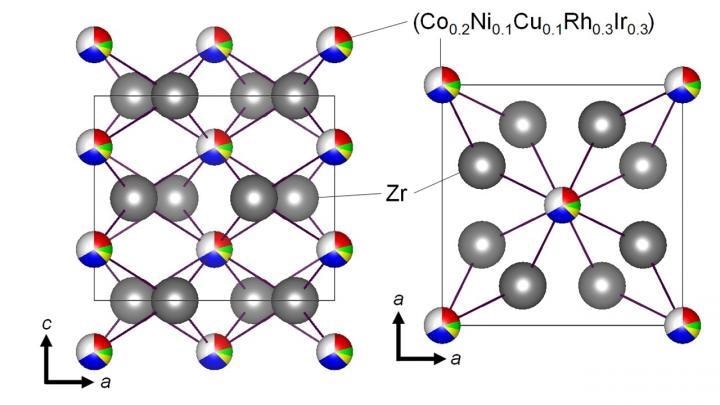Jan 11 2021
At Tokyo Metropolitan University, a team of scientists has combined and developed a new, high entropy alloy (HEA) superconductor with the help of expansive data related to simple superconducting substances with a particular crystal structure.
 Schematic of the CuAl2-type crystal structure of the newly created superconducting Co0.2Ni0.1Cu0.1Rh0.3Ir0.3Zr2 compound, with an HEA-type Tr site.
Schematic of the CuAl2-type crystal structure of the newly created superconducting Co0.2Ni0.1Cu0.1Rh0.3Ir0.3Zr2 compound, with an HEA-type Tr site.
It is well known that HEAs can retain superconducting characteristics even under very high pressures. The new superconductor developed by the team—Co0.2Ni0.1Cu0.1Rh0.3Ir0.3Zr2—undergoes a superconducting transition at 8 K, a comparatively high temperature for an HEA. The team’s technique could be applied to finding novel superconducting materials that exhibit particular desirable properties.
The phenomenon of superconductivity was discovered more than a hundred years ago when some materials were found to suddenly exhibit minimal resistance to electrical currents below a specific transition temperature. While scientists keep looking for different ways to prevent wastage of power, a technique to considerably reduce power transmission losses is a fascinating prospect.
However, the extensive use of superconductivity has been hampered by the demands of current superconductors, specifically the low temperatures needed. Researchers require a method to unravel new superconducting materials without the need for brute-force trial and error, and tune key properties.
A research group headed by Associate Professor Yoshikazu Mizuguchi from Tokyo Metropolitan University has been leading a “discovery platform” that has already enabled the design of several new superconducting substances. Their technique is based on high entropy alloys (HEAs) in which specific sites in simple crystal structures can be occupied by five or more elements.
The application of some HEAs to medical devices and heat-resistant materials showed that they exhibit superconducting properties with certain superior characteristics, specifically a retention of zero resistivity under very high pressures. The researchers surveyed material databases and most advanced research and found an array of superconducting materials that had a common crystal structure but different elements on particular sites.
Then, they combined and designed a structure that includes several of those elements; all through the entire crystal, the “HEA sites” are occupied by one of the combined elements. They have already been successful in developing high entropy variants of layered bismuth-sulfide superconductors and telluride compounds with a sodium chloride crystal structure.
As part of their latest study, the researchers focused on the copper aluminide (CuAl2) structure. Compounds formed by mixing a transition metal element (Tr) and zirconium (Zr) into TrZr2 with this structure are found to be superconducting. In this case, Tr could be Fe, Sc, Ni, Co, Ga, Cu, Pd, Rh, Ir, or Ta.
The researchers mixed a “cocktail” of these elements with the help of arc melting method to form a new HEA-type compound—Co0.2Ni0.1Cu0.1Rh0.3Ir0.3Zr2—which exhibited superconducting properties.
They analyzed electronic specific heat and resistivity, as well as the amount of energy consumed by the material’s electrons to increase the temperature, and found a transition temperature of 8.0 K. This value is not just comparatively high for an HEA-type superconductor, the researchers also confirmed that the material had the hallmarks of “bulk” superconductivity.
The most fascinating feature of this is the enormous range of other transition metals and ratios that can be investigated and adjusted to aim for higher transition temperatures and other preferrable properties, all without modifying the fundamental crystal structure. The researchers are hopeful that their success will pave the way for more discoveries of new HEA-type superconductors very soon.
Journal Reference:
Mizuguchi, Y., et al. (2021) Superconductivity in CuAl2-type Co0.2Ni0.1Cu0.1Rh0.3Ir0.3Zr2 with a high-entropy-alloy transition metal site. Materials Research Letters. doi.org/10.1080/21663831.2020.1860147.